| Problems in Identification: Flightless Females
|
In several families of North American moths we find
genera of flightless females. In the Lymantriidae which includes the
Tussock Moths the entire genus Ogyria has wingless females. Also within
this family are a couple of fully-winged females that are apparently too
heavy bodied for flight. These include the female of the infamous Gypsy
Moth, Lymantria dispar and females of two alpine species in the
genus Gynaephora.
|
| Wingless Female: Live Oak Tussock Moth -- Orgyia detrita
|
Typical of the Tussock Moth genus Ogyria, females
are virtually wingless and absolutely flightless. They eclose full of
eggs and ready to mate. By releasing a pheromone they "call" males to
them. They are usually ready to lay fertilized eggs shortly after
mating. The eggs are laid on the cocoon and may be covered with a
foamy protective covering. The entire process from eclosure to egg
laying and female death may be completed within 24 hours.
|
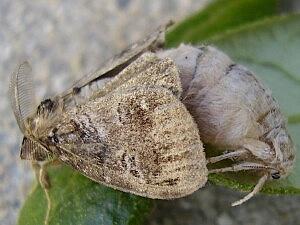 mating - all photos ©
Machele White mating - all photos ©
Machele White
|
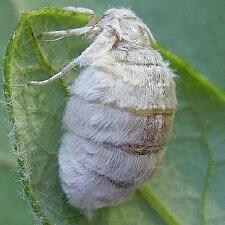 egg laden female egg laden female
|
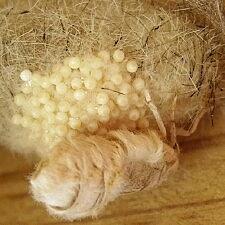 female, egg mass on
cocoon female, egg mass on
cocoon
| |
| Wingless Female: White-marked Tussock Moth -- Orgyia
leucostigma |
The foamy egg mass is here seen with a little bit
of the cocoon appearing behind it. The cocoons are typical found in
crevices of trees that have roughly textured bark. But they might also
be found on other vertical surfaces such as fences and walls of
building. In this instance the female is shown in an unnatural
setting. She eclosed from a cocoon that I brought indoors for study
and I took her outside for a photograph in sunlight. She laid
infertile eggs because I did not provide her with an opportunity to
"call" for males.
|
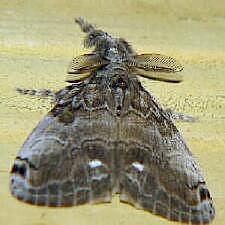 male - © Robert
Patterson male - © Robert
Patterson |
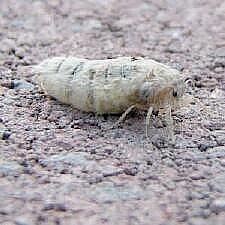 female - © Robert
Patterson female - © Robert
Patterson
|
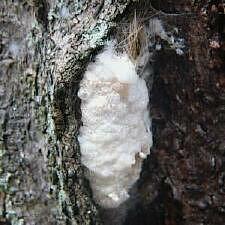 egg mass - ©
Robert Patterson egg mass - ©
Robert Patterson
|
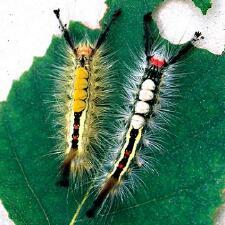 larva - ©
Janice Stiefel larva - ©
Janice Stiefel | |
| Wingless Female: Western Tussock Moth -- Orgyia vetusta
|
Joyce Gross found numerous cocoons and larvae of
this species at the University of California at Berkeley. Her paper
showing parasitoid activity in this population may
be seen here. The caterpillars in Joyce's study were feeding on
leaves of a Coast Live Oak. Last instar caterpillars tend to disperse
prior to entering the pupation stage. In this case many of them
attached their cocoons to walls of one of the nearby university
buildings.
|
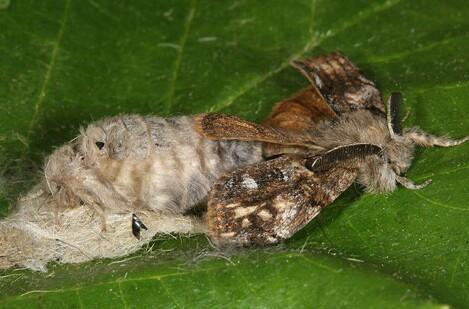 mating pair,
reared indoors - © Joyce Gross mating pair,
reared indoors - © Joyce Gross |
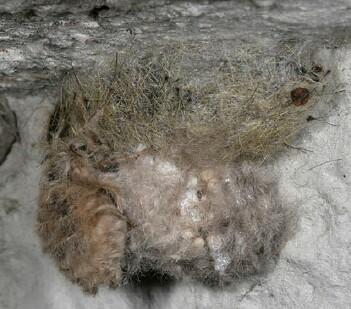 female,
hair-covered egg mass on cocoon - © Joyce Gross female,
hair-covered egg mass on cocoon - © Joyce Gross
| |
| Flightless Females: Members of the Geometridae
|
Within the large family Geometridae there
are several genera in which females have very reduced wings. Some
appearing to be virtually wingless. The genus Phigalia is
sometimes referred to as the half-wing moths and one of its members is
indeed known by that common name. Since females can't fly (they can
crawl) dispersal in these species takes place mainly in the
caterpillar stage.
|
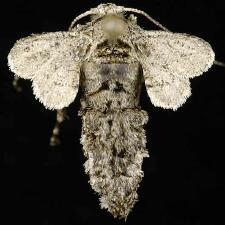 The Half-wing Moth -
Phigalia titea The Half-wing Moth -
Phigalia titea
© Anthony W. Thomas - NB
|
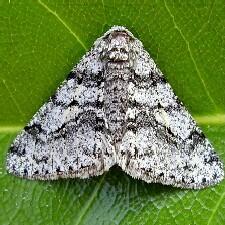 The Half-wing Moth -
Phigalia titea The Half-wing Moth -
Phigalia titea
male - © Machele White - FL |
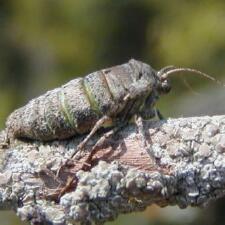 Wooly Gray Moth -
Lycia ypsilon Wooly Gray Moth -
Lycia ypsilon
© Randy Newman - NC |
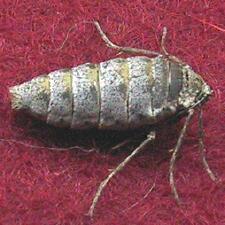 Linden Looper Moth -
Erannis tiliaria Linden Looper Moth -
Erannis tiliaria
© Larry Line - MD
| |
| Flightless Females: Members of the Psychidae |
Another interesting family with flightless
females is the Psychidae or Bagworm Moths. With only about 25
member species in North America they are relatively small and poorly
known although widely distributed. Caterpillars build silken cases
about them, adorned with needles, or pieces of bark or leaves from the
tress they inhabit. These cases provide protection for feeding larvae
and become pupation chambers, and females, who are usually wingless
(or have tiny vestigial wings), in most cases never leave the cases.
Males, who can fly and do leave the case at eclosion, find females by
keying in on pheromones release to attract them. Mating takes place
when a male inserts his abdomen into an opening in the female's case
(without ever actually seeing her). Eggs are laid in the case and,
upon hatching, larvae disperse to build their own cases and continue
the life cycle. Upon leaving the case a male may leave an exuvium,
remains of the last larval skin, dangling from the exit port as seen
at right, below.
|
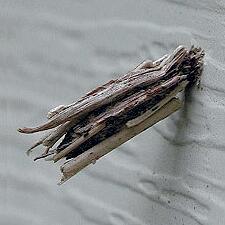 Psyche casta Psyche casta
© John Himmelman - CT
|
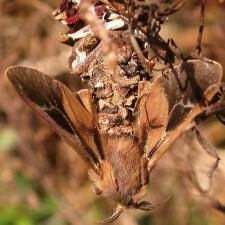 Abbot's Bagworm -
Oiketicus abbotii Abbot's Bagworm -
Oiketicus abbotii
© Jeff Hollenbeck - FL |
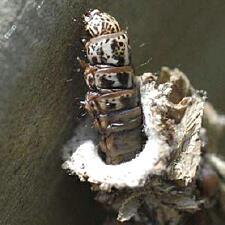 Exposed Case, Bagworm
Larva Exposed Case, Bagworm
Larva
© Charles Lewallen - OK |
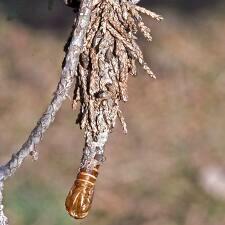 Evergreen Bagworm
male case Evergreen Bagworm
male case
© Charles Lewallen - OK
| |
 mating - all photos ©
Machele White
mating - all photos ©
Machele White  egg laden female
egg laden female
 female, egg mass on
cocoon
female, egg mass on
cocoon  male - © Robert
Patterson
male - © Robert
Patterson  female - © Robert
Patterson
female - © Robert
Patterson  egg mass - ©
Robert Patterson
egg mass - ©
Robert Patterson  larva - ©
Janice Stiefel
larva - ©
Janice Stiefel  mating pair,
reared indoors - © Joyce Gross
mating pair,
reared indoors - © Joyce Gross  female,
hair-covered egg mass on cocoon - © Joyce Gross
female,
hair-covered egg mass on cocoon - © Joyce Gross
 The Half-wing Moth -
Phigalia titea
The Half-wing Moth -
Phigalia titea  The Half-wing Moth -
Phigalia titea
The Half-wing Moth -
Phigalia titea  Wooly Gray Moth -
Lycia ypsilon
Wooly Gray Moth -
Lycia ypsilon  Linden Looper Moth -
Erannis tiliaria
Linden Looper Moth -
Erannis tiliaria  Psyche casta
Psyche casta
 Abbot's Bagworm -
Oiketicus abbotii
Abbot's Bagworm -
Oiketicus abbotii  Exposed Case, Bagworm
Larva
Exposed Case, Bagworm
Larva  Evergreen Bagworm
male case
Evergreen Bagworm
male case